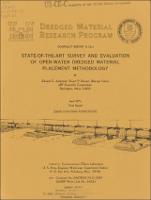Please use this identifier to cite or link to this item:
https://hdl.handle.net/11681/47331| Title: | State-of-the-art survey and evaluation of open-water dredged material placement methodology |
| Authors: | Johanson, Edward E. Bowen, Stuart P. Henry, George |
| Keywords: | Dredging Dredges Dredging spoil Dredged material Dredged Material Research Program (U.S.) |
| Publisher: | U.S. Army Engineer Waterways Experiment Station |
| Series/Report no.: | Contract Report (Dredged Material Research Program (U.S.)) ; no. Contract Report D-76-3 |
| Abstract: | The dumping of dredged material into a borrow pit is feasible using hopper dredges provided that an auxiliary navigation capability is available such as an instrumented buoy at the center of the borrow pit or an electronic precision navigation system. Borrow pit dumping is less easily undertaken with barges and tug boats because of the inability to accurately control the position of the barges. Borrow pits must be several acres in size and have dimensions sufficient to allow radial spreading of several hundred feet. Very little field data is available to establish the actual depositional dimensions of discrete disposal operations. Mathematical models simulating the disposal event have not been verified but appear to adequately simulate the phenomena observed in the few field research efforts undertaken. Estimates of the long-term fate of dredged material placed in a borrow pit cannot be made at the present time. If the material is cohesive, borrow pit sites should be selected that have bottom current velocities of 0.1 ft/sec or less and the dumping operation should be done at a time of year to allow several months for stabilization to occur prior to the winter storm season. Polluted dredged material can be covered over with sand within a borrow pit by a modified hopper dredge at a cost of approximately $2500/acre. The time of the covering process would be dependent on the polluted sediment type. If the material were fine-grained, a period of time would have to be allotted for stabilization so that it could support the weight of the cover material. However, the covering concept is not considered an efficient means of preventing pollutant removal and resuspension unless it can be undertaken immediately after disposal. Field and laboratory studies should be initiated to identify and quantify the physical mechanisms associated with open-water disposal operations. The field studies should be undertaken at typical disposal sites and should evaluate different sediment types and compare potential erosion and resuspension rates. The effects of different dredging techniques need to be investigated to determine the importance of water content, composition, cohesive strength, and flocculation. A field demonstration and evaluation of the horizontal pump-down concept should be developed. |
| Description: | Contract Report |
| Gov't Doc #: | Contract Report D-76-3 |
| Rights: | Approved for Public Release; Distribution is Unlimited |
| URI: | https://hdl.handle.net/11681/47331 |
| Appears in Collections: | Contract Report |
Files in This Item:
| File | Description | Size | Format | |
|---|---|---|---|---|
| Contract Report D-76-3.pdf | Contract Report D-76-3 | 11.34 MB | Adobe PDF |  View/Open |